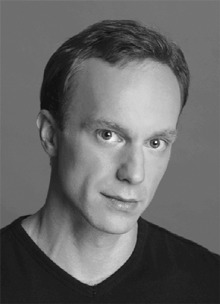Peter Boal presents his company at the Joyce on eve of move to Pacific Northwest Ballet
Peter Boal’s adventures with the small group of highly trained dancers and choreographers in his eponymous company are about to play out on a new state, with Boal’s new posting as artistic director of the Pacific Northwest Ballet in Seattle. After 30 years dancing with City Ballet, Boal is far from retiring from the dance world, as evinced by his company’s recent performance on March 15 at the Joyce.
Wendy Perron’s “Finding” was performed as a swan song given Boal’s move to the Northwest. In this solo, created for him in 1993, Boal takes wing in a loose and reflective manège encircling the stage. He doesn’t actually leave the ground, but finds something to grasp while running backward and forward. The metaphor for changing phases in life and perpetually searching and finding offers an uplifting and poignant start to the evening. A simplified boot form appears in a new backdrop projection by Lyle Starr. Inside it, progressively smaller silhouettes––a leg, then a full figure––signals the theme of moving on. It could be sentimental, but “Finding” isn’t.
The music varies in this program of unrelated works that are put together well. “Finding” is set to Phillip Glass’s “Mad Rush,” live piano movingly performed by Elaine Chelton. Daniel Nagrin’s 1948 “Strange Hero,” is set to jazz of Stan Kenton and Pete Rogolo. This gem is definitely of its time, but classic. Sean Suozzi dances in solo in a brown suit with a dangling unlit cigarette. He is as natural standing on his shoulders as he is upright. Suozzi righteously expresses the innocence of the lone gangster with fluid hips, jazz walks, turns and skates. David Moodey’s fine lighting evokes vicissitudes of time and mood.
Boal & Company’s syncopated and dramatic movement is a distinct entity. While the music is less paramount, the choreography is its sophisticated mate. Edwaard Lliang’s premier “Distant Cries” is a duet for Boal and Wendy Whelan. This showcase for their musicality and dramatic dancing is set to the baroque master Tomaso Albinoni. Boal, resilient and corporeal, expresses the humanistic spirit he admires in his choreographers. He proves a gallant, even paternal partner. He lifts the elusive Whelan, who is walking away, above ground. Whelan is delicate as glass but superbly elastic; her character is visibly unhappy. Boal interestingly disappears into the dark more than once, leaving Whelan to her insular thoughts. The “Distant Cries” at the Joyce are those of Lliang, Whelan, and their departing fellow City Ballet dancer Boal.
Shen Wei claims he likes to mine the individual strengths of his dancers. This is sometimes hard to see in Shen Wei Dance Arts. Whelan chose this choreographer to set a solo for her. “Body Study III,” a premiere, confirms Shen’s claim. Whelan, in Shen’s signature stolid pose with direction changes and a slowly circling arm, still looks like herself. Her arms and hips rotate and her feet in toe shoes do figure eights on the floor. Shen glorifies her angular balletic movement and the cool intensity in her androgynous form. This modern choreographer frees the essence of Whelan’s beauty.
Victor Quijada’s premiere “Soft Watching the First Implosion,” though set to Vivaldi, is futuristic, a release. Two City Ballet dancers, Suozzi, and Andrew Veyette, perform with the hip-hop master in a rubberbandance, the apt name of Quijada’s Montreal company. They change positions through a series of blackouts, the game being very tongue-in-cheek, though the sight gags don’t break new ground. Quijada supports Veyette in a crimped flexed mid-air pose. He takes it in stride but Suozzi doesn’t abandon his verticality convincingly in the compacted stunts. Quijada’s incredible stage presence and movement style carry the cautious piece.
The opening night audience was full of past and present ballet stars and Lliang, Nagrin, Perron and Shen joined the performer’s curtain calls.
Boal plans to bring Robbins and Balanchine classics, Susan Marshall’s “Kiss” and Twyla Tharp’s “Nine Sinatra Songs” to the PNB company of close to 50 dancers.
gaycitynews.com


































